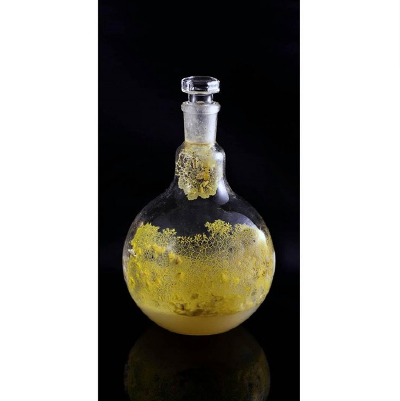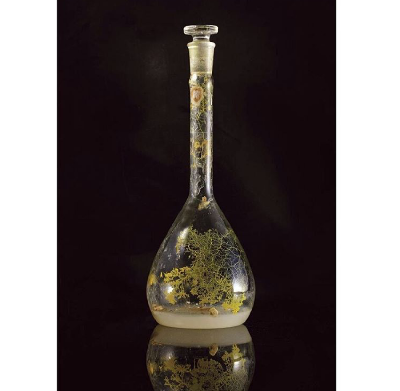Projekt
PHYSARUM is
the singular aroma of a cool damp forest
the vibrant yellow of a saucy lemon
the relentless rhythyms of nature of multiple cycles
the storehouse of countless answers
the tantalizing challenge that lures us on
Physarum Polycephalum Literature
This Blog was established to provide a convenient point of connection for all those who are interested in Physarum polycephalum and related organisms. It is meant to serve not only the interests of scientists who are doing 'cutting edge' research using one of these remarkable biological systems but also the general public and young scientists who are deciding what research path(s) to pursue.
The amount of work done - and published - on any model biological system is vast. We do not attempt here to list all publications on Physarum and related species. [Modern search engines allow anyone with a computer and internet access to find more relevant publications than most can assimilate.] Instead, this section is a listing of books, major review articles, and monographs that visitors to this Blog may find useful. If anyone in the Physarum community is aware of such source material that I have not listed, please contact the Author and provide the relevant information.
University of Leicester: Physarum Groups Theses
| Name | Degree | Date | Title | LRA handle |
| Poulter, Russell | PhD | 1969 | Senescence in the Myxomycete Physarum Polycephalum | http://hdl.handle.net/2381/9814 |
| Wheals, Alan | PhD | 1971 | Mutants affecting plasmodium formation in a homothallic strain of Physarum polycephalum. | http://hdl.handle.net/2381/34369 |
| Cooke, David J. | PhD | 1974 | Studies on the Colonia isolate of Physarum polycephalum. | http://hdl.handle.net/2381/34311 |
| Sudbery, Peter | PhD | 1974 | Studies on the control of mitosis in the plasmodium of physarum polycephalum. | http://hdl.handle.net/2381/34477 |
| Hall, Leonard | PhD | 1975 | Co-ordination of macromolecular synthesis in Physarum polycephalum. | http://hdl.handle.net/2381/35241 |
| Plaut, Barbara | PhD | 1975 | Co-ordination of macromolecular synthesis in Physarum polycephalum. | http://hdl.handle.net/2381/35132 |
| Anderson, Roger | PhD | 1976 | Analysis of the amoebal-plasmodial transition in Physarum polycephalum. | http://hdl.handle.net/2381/35432 |
| Burland, Timothy | PhD | 1978 | Temperature-sensitive mutants of Physarum polycephalum: A search for cell cycle mutants. | http://hdl.handle.net/2381/34386 |
| Cunningham, William David | PhD | 1979 | DNA synthesis in Physarum polycephalum. | http://hdl.handle.net/2381/35199 |
| Blindt, Adrian | PhD | 1987 | Changes in cellular organisation during apogamic development in Physarum polycephalum. | http://hdl.handle.net/2381/34382 |
| Sweeney, Glen | PhD | 1987 | Differential gene expression in Physarum. | http://hdl.handle.net/2381/35166 |
| Bailey, Juliet | PhD | 1989 | Analysis of cellular events during plasmodium development in Physarum Polycephalum | http://hdl.handle.net/2381/35072 |
| Murray, Michael | PhD | 1990 | The genetic analysis of mlpA, a gene encoding a myosin-like protein in Physarum polycephalum. | http://hdl.handle.net/2381/34453 |
| Mellersh, Cathryn | PhD | 1991 | The study of expression of a plasmodial-specific gene in Physarum polycephalum. | http://hdl.handle.net/2381/34447 |
| Cook, Lynnette J. | PhD | 2000 | Studies of genes showing differential expression during plasmodium development in Physarum polycephalum | http://hdl.handle.net/2381/30324 |
| Swanston, Emma | PhD | 2000 | A study of developmentally regulated genes in Physarum polycephalum | http://hdl.handle.net/2381/30332 |
Physarum "Intelligence"?
A growing number of scientists are rethinking the question of intelligence. Defined by many as "purposeful action", intelligence is being recognized in - or at least suggested to be manifested by - various animals and even plants. Not to be left out, the community of scientists studying Physarum has reported on "intelligent" behavior by the true slime mold. Because this literature is so new (and somewhat controversial), we will be very selective in our coverage of such publications. But the fact is that a large number of people are attracted to Physarum by this literature and we as a community ought to acknowledge that growing interest, even if those of us who are 'rigorous scientists' feel obliged to treat the published findings (or the interpretation of those facts) with some skepticism.
Another reason for including some material in this section is that the interest in 'intelligence' has sparked the attention of some very gifted communicators and they are actually blurring the 'line' between reporting facts in conventional ways, with publicizing slime mold in a fashion that is almost media coverage. So, in the same sense that we often give consideration to reports that have some errors - because they also contain a great deal of 'truth' - we chose not to reject such coverage but to 'cover' it ourselves because we want to attract attention to our 'favorite' model system, even if we may be forced to explain what is fact and what is 'fancy'.
Main Concept
This section is devoted to those non-scientists (or fledgling scientists) who are interested in simple methods for culturing Physarum. Some of the documentation included here is not easily referenced, having come from websites that are no longer available, or having been obtained via web-surfing (e.g. Google) that yielded material in one search but not another. Wherever possible I have included, in the document, the URL from which it was obtained and/or an acknowledgment of the source. I apologize for any inadvertent infringement on copyright or "intellectual property" but ask forgiveness since the sole purpose of this section is to encourage the non-expert - especially young students - to give it a try and HAVE SOME FUN.

